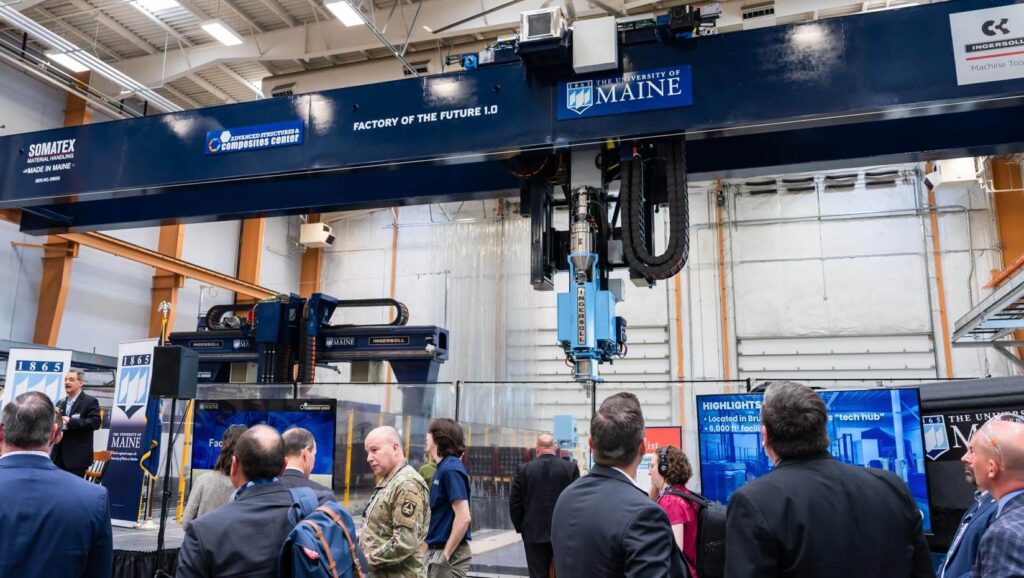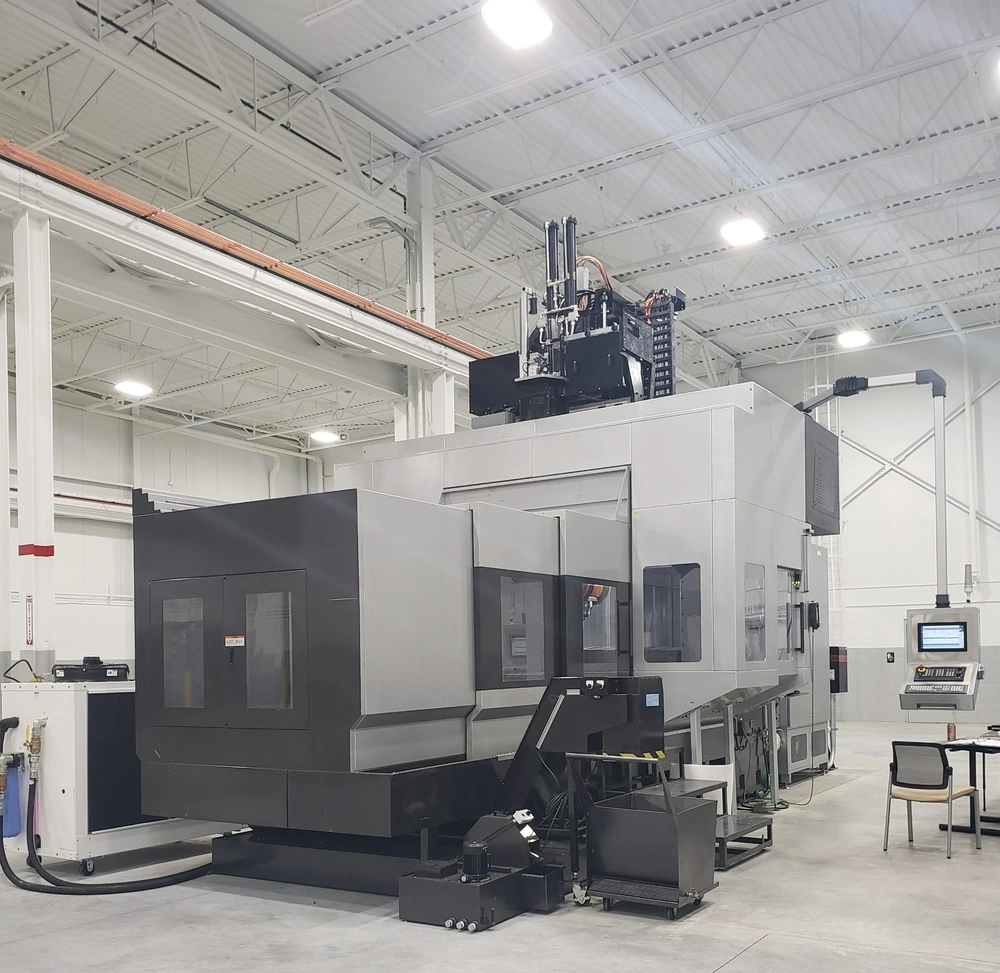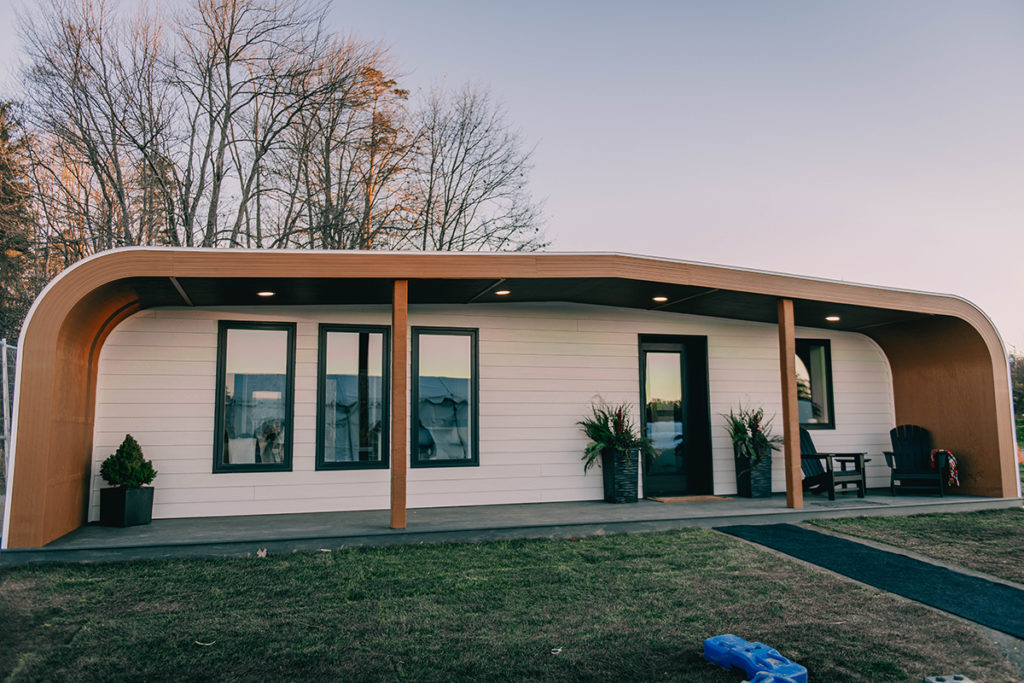World’s Largest Polymer 3D Printer Unveiled by UMaine: Houses, Tools, Boats to Come
The University of Maine has once again broken its own record by unveiling the largest polymer 3D printer in the world. Surpassing its 2019 achievement, the new Factory of the Future 1.0 (FoF 1.0) introduced on April 23, 2024 at the Advanced Structures and Composites Center (ASCC) is meant to drive progress in a number of industries, including national security, affordable housing, and renewable energy sectors.
How Big is the Biggest?
The unveiling event drew an audience comprising representatives from the U.S. Department of Defense, U.S. Department of Energy, the Maine State Housing Authority, and various industry partners. The FoF 1.0, capable of producing objects up to 96 feet in length, 32 feet in width, and 18 feet in height, and with a remarkable output rate of 500 pounds per hour, showcases a significant leap in large-scale additive manufacturing (AM) capabilities.
As with the MasterPrint before it, the FoF 1.0 was developed in collaboration with Ingersoll. In addition to growing the footprint of UMaine’s technology, the new system incorporates multiple advanced manufacturing processes including subtractive manufacturing, continuous tape layup, and robotic arm operations. This integration allows for more dynamic manufacturing solutions, capable of producing complex multi-material objects. Access to both the FoF 1.0 and its predecessor, MasterPrint, is expected to significantly enhance research and innovation in manufacturing at the ASCC. The two systems can collaborate on the same part and share end-effectors.

The development of the FoF 1.0 was supported by the Office of the Secretary of Defense through the U.S. Army Corps of Engineers. U.S. Senator Susan Collins, who has secured over $93 million for the ASCC since 2022, said this of the new machine:
“UMaine and the Advanced Structures and Composites Center possess the innovation, capacity, and workforce to support the future needs of the Department of Defense in advanced manufacturing. This is a great day for our University, our State, and our Nation. I congratulate President Joan Ferrini-Mundy and Dr. Habib Dagher on another important milestone and look forward to witnessing this Center’s continued innovation that is invaluable to our national security.”
What Can You Do with a Giant 3D Printer?
UMaine has already demonstrated some truly impressive applications with the MasterPrint, including an entirely biopolymer house, wind turbine molds, and boat hulls. Ingersoll, meanwhile, has 3D printed tooling for helicopter blades and expanded a MasterPrint to 3D print metal for the Jointless Hull Project. In other words, not only can we expect the FoF 1.0 to be used to 3D print even bigger houses, boats, and tools, but we may even see the technology ported over to metal. This would certainly justify Collins’ support, given her role as vice chair of the Senate Appropriations Committee and Subcommittee on Defense.

The Army’s Jointless Hull subsection tool is a hybrid metal additive manufacturing machine used for engineering development and production in support of the full-size Jointless Hull machine located at Rock Island Arsenal – Joint Manufacturing and Technology Center. The full-size machine will be capable of producing large metal parts such as monolithic hulls for military ground vehicles. Image courtesy of the U.S. Army.
“FoF 1.0 opens up new research frontiers to integrate these collaborative robotics operations at a very large scale with new sensors, high-performance computing and artificial intelligence to create born-certified systems that meet high quality standards,” said ASCC Executive Director Habib Dagher. “We are grateful for Senator Collins’ support, for support from Maine’s congressional delegation and for collaborations with the Department of Defense, Department of Energy, Oak Ridge National Labs, Maine Housing and our industry partners here in Maine and beyond.”
The introduction of the FoF 1.0 precedes the upcoming launch of a new 47,000-square-foot research facility named the Green Engineering and Materials (GEM) Factory of the Future, set to break ground in August. This laboratory is designed to drive advancements in manufacturing across various industries. Its main goal is to promote and expand environmentally friendly manufacturing techniques through the deployment of cutting-edge technologies and biomaterials. This initiative aims to tackle pressing issues like workforce shortages and supply chain limitations using localized approaches.
The research center will expand advanced manufacturing methods and investigate new material systems, focusing on recycled and bio-based materials. As the most heavily forested state, Maine annually generates over one million tons of wood waste from its sawmills, a resource that can be utilized as raw material for 3D printing. Furthermore, under the GEM initiative, the University of Maine is committed to workforce development in manufacturing. It offers hands-on learning and entrepreneurship training programs designed to cultivate future industry leaders.
“Maine needs an estimated 80,000 additional homes by 2030, many specifically for households with incomes at or below the area median income. This new technology allows UMaine-ASCC to scale-up its research and production of its innovative biobased 3D printed home technology,” said MaineHousing’s Development Director Mark Wiesendanger. “This effort creates another means of producing quality affordable housing, while further driving costs down, and using abundant wood residuals from Maine’s sawmills. We look forward to continuing our collaboration with Dr. Dagher, the staff and students at UMaine/ASCC in demonstrating how 3D printed homes and other next-generation housing technologies will quickly and efficiently contribute to enhancing Maine’s housing stock.”

The BioHome3D 3D printed by UMaine under the Hub and Spoke program. Image courtesy of UMaine.
Alongside its research and development efforts, the GEM Factory of the Future complements the creation of the Maine College of Engineering and Computing (MCEC). This statewide effort, supported by the Harold Alfond Foundation under the UMS TRANSFORMS program, focuses on building a workforce equipped for a world that is becoming more digitally interconnected and globally integrated.
Despite its size, the response from AM media more widely regarding the MasterPrint was somewhat understated. This was, perhaps, because the system’s development took place over several years, during which a number of largest and fastest and strongest 3D printing initiatives made headlines and many members of the industry had long become burnt out from hype.
However, if anything, the MasterPrint and, now, the FoF 1.0 are impressive achievements for UMaine, Ingersoll, and their partners—less so because of the size of the machines and more so because of the practical uses they’ve already performed. Moreover, the work that Collins and her colleagues in government have done exhibit the scale of what can be accomplished when public funding is strategically deployed.
All images courtesy of UMaine unless otherwise noted.
Subscribe to Our Email Newsletter
Stay up-to-date on all the latest news from the 3D printing industry and receive information and offers from third party vendors.
Print Services
You May Also Like
New Business: Temporary, Migratory, & Modular 3D Printed Architecture
If we look at potentially emerging 3D printing businesses, then architecture has not been fully explored. Yes, there is a lot of house 3D printing going on worldwide. From deployable...
3D Printing News Briefs, April 19, 2025: Material Extrusion Standard, Metal Powder, & More
In today’s 3D Printing News Briefs, we’re covering a proposed standard for material extrusion, before moving on to business and metal powder. We’ll end with a commercial store’s robotic 3D...
Japan Unveils World’s First 3D Printed Train Station
Japan is now home to what we believe is the world’s first train station built with 3D printing technology. Located in Arida City, just south of Osaka, the new Hatsushima...
restor3d Raises $38M to Expand 3D Printed Orthopedic Implants
Backed by $38 million in new funding, restor3d is pushing ahead with the launch of four personalized implant lines, set to roll out in 2025 and 2026. This latest venture...

























